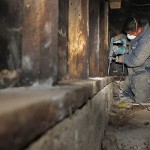 Companies report a surge in calls from homeowners after the earthquake and tsunami. The work can be expensive, and prices can vary widely.
Companies report a surge in calls from homeowners after the earthquake and tsunami. The work can be expensive, and prices can vary widely.
By Shan Li, Los Angeles Times
March 16, 2011
Like many construction businesses, Jonathan Weinstein’s company suffered during the economic downturn. Then, on Friday, the phones hardly stopped ringing.
Weinstein Retrofitting Systems Inc., based in Van Nuys, specializes in earthquake retrofitting for homes.
“Whenever there’s a big disaster anywhere in the world, it puts safety in the front and center of people’s minds,” said Weinstein, vice president of the family-owned company. The firm has had a threefold increase in phone calls since the disastrous earthquake hit Japan, he said. Some callers were merely anxious, others frantic.
“People feel compelled to do something,” Weinstein said.
Jacqueline Boucher, who is in escrow on a duplex in Mid-City, is among those who called the company. She had set aside $10,000 for window treatments and other cosmetic niceties. Then she watched whole Japanese fishing villages crumble like plastic toys and called Weinstein’s company.
Earthquake preparedness “just went to No. 1 on my priority list,” said Boucher, 40, who works as a clerk for the city of Los Angeles. “It’s not like it wasn’t a priority before. But now I believe one is coming, and it’ll be bad.”
Across earthquake-prone Southern California, other retrofit companies also saw a huge jump in calls.
Stern’s Construction Inc. in Woodland Hills hadn’t gotten such a high volume of inquiries since 1994. That was the year of the Northridge earthquake, which caused more than 60 deaths and 5,000 injuries, according to the Federal Emergency Management Agency.
“In 1994 every business saw a huge boom,” company owner Terry Stern said. “We were doing 1,500 houses a year.”
There have been numerous other massive quakes since then, such as in Haiti last year. But the temblor in Japan especially struck a nerve.
“The average person might not be able to tell you exactly where Haiti is,” said Mike Goldberg, owner of White Castle Construction in Los Angeles. “But people can really identify with Japan. They probably drive a Japanese car. It’s more real to them and it really hits home.”
Owners of commercial buildings did not, for the most part, join in the frenzy to get retrofitted, said Steven Saunders, president of Saunders Commercial Seismic Retrofit in Costa Mesa.
“These are people with large properties, and they tend to be far more rational than individual homeowners,” Saunders said. “They have a schedule for when to do repairs or to retrofit their buildings. They can’t be scared and decide to do these projects in a week.”
Some homeowners who contacted Goldberg’s business were definitely in panic mode. He said a Los Angeles woman, who was out of town on vacation, harangued her sister into swinging by his office to drop off a deposit in $100 bills. It was an attempt to secure an early place in line for retrofitting.
Retrofitting homes can be expensive, and prices can vary widely. Companies send workers into crawl spaces under houses to strengthen foundations with concrete, if needed, and bolt down wooden frames.
Reinforcing homes with metal rods or brackets, the minimum required for stability, typically costs a minimum of about $3,000, according to several construction companies. A cracked foundation or other serious problem could ratchet up the price several times that amount.
That demand after the Northridge earthquake tapered off as memories of the event faded.
Goldberg’s company did get a small upsurge in retrofitting business during the recession from people wanting to protect their most valuable possession — their homes.
“They were basically saying, ‘I can’t tell you definitely I’m going to have a job soon, but I can tell you if I lose my house in a quake I am really up the creek,” Goldberg said.
Still, even in affluent neighborhoods such as Hancock Park and Beverly Hills, there are numerous unretrofitted homes built before stringent safety requirements, Stern said. He referred to these buildings as an “untapped market.”
Eric Scott, 27, bought a home in Granada Hills in 2008 that an inspector’s report described as “partially retrofitted.” It didn’t bother him, however, because the house had sustained no damage as a result of the 1994 earthquake centered in nearby Northridge.
“I never even read the report to figure out what ‘partially retrofitted’ meant,” Scott said. “I was excited to do other things, like buy new furniture.”
Then, he watched the near-constant coverage of what happened in Japan.
“It was very in your face and very tragic,” Scott said. “The first thought that came to my head immediately was I’ve got to get my house fixed. Now.”